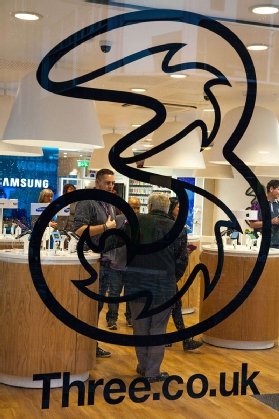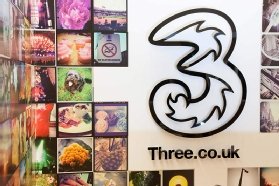
Three
Five not the only magic number for Three in 2021
With a new CEO beginning to put into practice its plan, mainly a pivot towards business, mobile operator Three UK has been eyeing up new opportunities in 2021. We see what is on the agenda
With the old year behind us and much of the new one ahead, before casting an eye to the future it seems right, especially given that we are talking about 2020, to look back and see just what a tortuous 12 months it was for the communications industry.
This time a year ago, a lot of the smart money and smart opinions were on 2020 being the year in which the accelerator pedal would be pushed down for comms, particularly mobile with 5G hitting top gear, with many predicting (and in some cases hoping for) use cases to be realised and translated into functioning businesses. And yet, while the Covid-19 pandemic did hinder the pace of 5G development, it most certainly did not put the brakes on the development of the communications industry as a whole. What we saw was not a slide back but a reshaping.
While the mass 5G roll-outs and use cases did not materialise as hoped, nor were they written off. Indeed, communications infrastructures, both fixed and mobile, became more important than ever before, and the year ended with increased investment in networks and 5G-related business set to soar.
A December 2020 study released by Qualcomm Technologies forecasts a potential 5G-related boom over the next 15 years, despite the Covid-19 pandemic’s effects on the global economy, with a 10.8% net increase in global 5G investment compared with the 2019 forecast, and an increase in 5G-related jobs to 22.8 million by 2035. These jobs and opportunities are going to be across the applications spectrum.
While successful applications for 5G to date have been within the consumer segment, it seems certain that more business-oriented use cases will come to the fore in 2021. Aiming to tap into this dynamic will be Three UK.
Driving 5G into business
Having spent 2020 laying the groundwork for a 5G network which, to date, has focused on consumer-centric services, Three UK has announced a greater emphasis on better addressing the business sector – an area it feels offers a great opportunity for growth. The firm’s achievements in 2020 will form the stakes in the ground for the forthcoming 12 months. These include improvements to its existing 4G network – with all 4G traffic now on the company’s cloud core infrastructure – the launch of 20 new datacentres, but principally the acceleration of 5G.

Three’s 2021 go-to-market strategy will be centred around the further roll-out of 5G nets, 5G home broadband and a concentrated push into the business sector with offerings slated to launch in the second half of the year. The 5G networks are built around technology from Ericsson, a deployment decision made on the back of the UK government’s mandate to remove Huawei technology from the nation’s mobile infrastructure.
The company assures that it is going to build on the promises made in 2020, particularly around its network, which will see enhancements in the network experience and all other experiences for customers. At the heart of making sure this happens will be Three UK chief operating officer (COO) Susan Buttsworth. The executive has been with Three UK owner Hutchinson Group for 25 years, and with three UK since October 2019. When she came on board, the company did not have any 5G sites; at the end of 2020, it had around 1,000 in 154 locations across the UK.
Looking ahead at the challenges for 2021, she reiterates the promise about the network but adds that the new offer is really all about spectrum. “The network strategy is all around the customer and the connectivity for the customer. It’s actually our top priority,” she stresses. “We have got a really strong 5G spectrum position, multiple times more than the closest competitor in terms of our spectrum availability. As the customer requirements for bandwidth increase, it becomes even more important what our spectrum holdings are.”
Buttsworth reels off statistics as to what activity has been taking place at Three UK, not only in 5G but across the board. The company has done about 4,500 4G upgrades and is investing about £2bn in the network. The 4G upgrades are regarded to be as important as the number of 5G sites because the objective is about the network in total – not just about “5G, 5G and 5G”, she says.
That said, as an indication of how much the 5G business has grown, when Buttsworth arrived, the 5G core was carrying 18% of traffic – that figure is now up to 100% for 4G and 5G. While Three is still working under a contract with Huawei for essential equipment, Buttsworth is adamant that the company’s deal with Ericsson will mitigate any issues regarding the removal of the former’s technology from communications infrastructures going forward.
She reveals that Three UK changed its procurement strategy when the UK government first announced in January 2020 that it would exclude Huawei from networks, and proceeded immediately to engage with an alternative provider so that it would be in a strong position for the rest of the year. She adds that the company signed with Ericsson the day before the government’s second announcement regarding the issue in July 2020, which introduced much more stringent limitations.
Rising to the Covid challenge
All of which means that with its mobile offering, and with backhaul fibre services supplied by companies including CityFibre, Three UK is set up for whatever the Covid-defined business environment throws at the firm. Buttsworth is very clear as to the extent of the transformation the pandemic has brought about, not only to her company but the working environment of customers.

“If we didn’t know before Covid how essential the telecoms networks were, we certainly do now”
Susan Buttsworth, Three UK
“If we didn’t know before Covid how essential the telecoms networks were, we certainly do now,” she observes. “And we believe that the changes that have arisen from Covid are sustainable, so even once the pandemic becomes controlled, we don’t think we will see people being driven back into the office five days a week. We think that the traffic patterns [and] changes that we’ve seen are around usage are going to persist in the future.
“For one thing, the increase in data volumes has been about 10% overall, with about a 15% increase in peak throughput. We got about a 42% increase in [cellular] voice, and the times of day [for peaks] have changed as well. The data peak has stayed similar, at about 9pm, but for voice it has changed significantly, from 3pm to 5pm to about 10am to 2pm. And we have definitely noticed a move in terms of congestion. So we’ve seen about 40% of our sites now have completely different traffic profiles than before Covid,” she says.
Buttsworth accepts that this means Three UK, like its customers, has had to adapt to the new circumstances. “We think the adjustment is going to be with us, insofar as people are not just going to automatically revert back to what they were doing pre-Covid. We believe that is also a consideration for driving the move to fibre, because you need a better [connection], not just in London, [but also] in a lot of other areas. We see the impacts of Covid and we’re now feeding them into our roll-out strategy, adjusting where we need to put our sights first, based on these revised traffic patterns.”
It’s not only traffic patterns that are being revised for Buttsworth, but also her core responsibilities in these challenging times as both the networks and the working landscape change. In addition to noting that aspects of the role have differed considerably, in ways that couldn’t have been anticipated, she remarks that the challenges of the past 12 months have been associated with the network, and with managing personnel within the context of Covid. The job has also changed in terms of products and services and how Three UK is responding.
“Our customer demand changed, and we have had to be very responsive in a very short time to some circumstances,” says Buttsworth. “We have a large contact centre in India, and [when the country] announced its Covid restrictions and locked down, this gave us four hours’ notice to provide customer service to our customers. We were [opening] pop up contact centres in a week and with the technology that supports that. So, there have been a lot of challenges that I don’t think that we could ever have predicted, and they are pervasive. You absolutely have to be agile, in both a personal and a business context. I think we’re all getting better at it.”
Focusing on customer benefits of 5G
But fundamentally, it’s the network that will be the key – the lifeblood of the company and its customers, Buttsworth emphasises. Outlining her priorities, she says Three UK will be asking what it all means for the customer, which will mean a different approach in addressing their needs.

One of the first steps in understanding what 5G means for the customer, she says, will be to stop talking about 5G per se and start talking about use cases and how customers can get value out of the new infrastructures. For example, how to get better use of high-definition video – the latency, the reliability. And also elements that have yet to be discovered. Just like it was 20 years ago with the arrival of the third-generation networks.
“We’ve already seen that fixed wireless broadband is a good replacement for customers. It’s easy to implement with just a device in the window. You don’t need to have people doing construction on your house, and it’s very convenient. And it means you’re not tethered to a geographical location, so it’s helped people when there’s been [a lot of people] trying to co-habit, doing schoolwork and work and everything,” she explains.
“I also think the customer will benefit in ways that we haven’t yet predicted because new businesses will come out of 5G. I’ve no doubt about that because that’s what happened with 3G. And it’s really about what we’re doing for the customer that is going to make the difference in the future, which is what we’re focused on.”
Read more about UK telecoms
- UK mobile operators join scheme to help families that need access to connectivity to support their child’s learning needs during the latest lockdown, while BCS calls for free mobile access to education sites.
- Research finds full realisation of 5G could deliver significant additional economic growth for the UK, with three industries accounting for more than three-quarters of projected business.
- Comms carrier and tech companies continue to drive advancements in 5G technology using aggregation technology on mmWave spectrum while new portfolio of 5G RAN platforms aims to enable a new generation of cellular devices.








